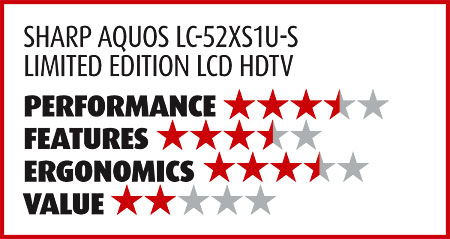Sharp LC-52XS1U-S LCD Flat Panel Page 2
 At one point, I saw a flickering blue discoloration in one corner of the screen—likely an unstable LED. But it cleared when I turned the Sharp off and then on again. That’s the only time this occurred in the 30-plus hours I spent with this set.
At one point, I saw a flickering blue discoloration in one corner of the screen—likely an unstable LED. But it cleared when I turned the Sharp off and then on again. That’s the only time this occurred in the 30-plus hours I spent with this set.
One of the most nagging problems with LCDs is the way their performance degrades as you move off axis. The image begins to fade noticeably at angles as small as 10 or 20 degrees (depending on the set and the viewer). It continues to wash out gradually as you move farther to the sides, until all you see at an extreme angle are pale pastel colors. Unfortunately, the LC-52XS1U-S also has this problem. While you can check this in a store demo, be aware that the ultra-bright settings in retail showrooms tend to minimize its visibility.
Getting Down to Business
When I finally set up my calibration gear, I got a puzzling surprise. As I suspected from my initial look at the set, the Low setting of the Color Temp control was a bit high (tinted toward blue). It hovered at around 7000K across most of the brightness range rather than the 6500K/D6500 target. It rose even higher at low brightness levels.
But when I tried to tweak the results with the set’s red, green, and blue white-balance controls, I found that they had little effect. When I turned the blue control to its minimum setting (–30, with an overall range of –30 to +30), the color temp dropped only slightly. The red and green controls either had no effect or, at some settings, threw off the color temperature even more.
Sharp suspected a defective AVC and sent me another sample to use with the same panel. But the new one was worse than the first. At its Low Color Temp setting, the measurements approached 8000K at peak white (100 IRE). Also like the first box, the white-balance controls had minimal effect. The other fixed Color Temp settings were even worse, rising to a ridiculous 35,000K on High.
I quickly went back to the original controller. The best result I could get (shown in the measurement section) isn’t terrible, but we’ve done much better than this with a number of far cheaper sets.
I did try to use the CMS controls to bring the Sharp’s color gamut more into line with the Rec.709 (HDTV) color standard. While they pulled in the color points slightly, the controls not only lacked the range for a perfect result, they also reduced the intensity of the colors, particularly red. That’s why a properly designed color management system needs an intensity (brightness) control for each color, which the Sharp doesn’t have. I returned the CMS controls to their neutral positions and used the unmodified Standard setting for the remainder of my tests and viewing.
Wrapping It Up
I’d be lying if I said this set didn’t produce a great picture. It offers deep blacks and shadow detail that are beyond the capability of all but a few other sets on the market. It also has excellent video processing, and resolution to die for. On the final evening of my testing, I watched much of King Kong and The Incredible Hulk on Blu-ray, plus parts of the Academy Award HD broadcast and a high-definition rerun of a Stargate: Atlantis episode. They all confirmed my previous impressions of the set. Apart from that slight blue color shift, I had no subjective complaints. On the contrary, the set’s picture was consistently compelling.
The average viewer will likely be delighted with practically every aspect of this set’s performance, even the color. But while the off-axis viewing angle may simply be an intractable issue with LCDs for the present, I can’t gloss over the fact that the lowest color temperature setting was well removed from the D6500 standard. I also can’t ignore the lack of usable color adjustments, the differences in the two controller boxes Sharp sent me, or the oversaturated color gamut in either of the available options.
I can forgive these shortcomings (to a degree) in a popularly priced set. But for $12,000, a buyer deserves a set that can be made as accurate as the state of the art allows. I didn’t see that here. Until I do, in spite of the many things I appreciate about its image quality, I can’t recommend the Sharp LC-52XS1U-S.

- Log in or register to post comments



































































